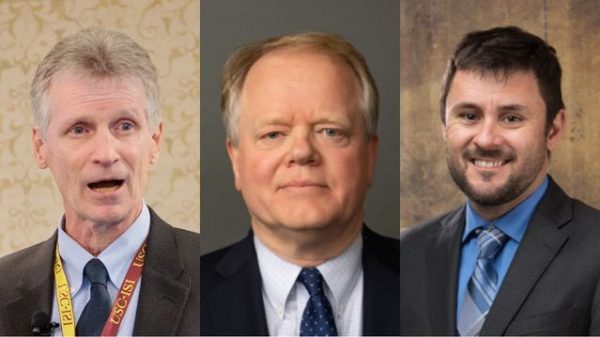Three Experts Join SERC Research Council

The SERC Research Council is adding expertise in aeronautical engineering, space systems, procurement law and other topics with three new members: Dr. Michael Orosz, Dr. Daniel Selva, and Mr. Christopher Yukins, JD.
The council includes roughly a dozen members with diverse experience in systems engineering and related fields who help shape the SERC research portfolio, conduct their own research, and act as ambassadors for the networked University Affiliated Research Center (UARC).
“The SERC Research Council forms the foundation and provides a vision for much of what we accomplish with our research,” said Executive Director Dinesh Verma. “Adding Dr. Orosz, Dr. Selva, and Mr. Yukins will broaden and enhance the expertise we can provide to our sponsors in the Department of Defense.”
Dr. Michael Orosz directs the Decision Systems Group at the University of Southern California’s Information Sciences Institute and is a research associate professor in USC’s Department of Civil and Environmental Engineering. His research interests include systems engineering, decision systems, open source intelligence analytics, data analytics, cyber-physical security, and intelligent human-computer interfaces.
Orosz has conducted SERC research for the United States Space Force, including projects titled “Global Positioning Systems – Mission Engineering and Integration of Emerging Technologies” and “SSC/CG Military Communications & Positioning, Navigation, and Timing – Mission Engineering and Integration of Emerging Technologies.”
Dr. Daniel (Dani) Selva is an assistant professor in the Department of Aerospace Engineering at Texas A&M University, where he directs the Systems Engineering, Architecture, and Knowledge (SEAK) Lab. His research interests address the intersection and the union of space systems, artificial intelligence, and engineering system design.
Selva’s SERC contributions include collaborating on project titled “New Project Incubator.” He also recently contributed a report for the SERC’s companion UARC, the Acquisition Innovation Research Center (AIRC), which hosts Selva’s “Cognitive Assistant for Training Cost Estimators.”
Mr. Christopher Yukins has served as a trial attorney with the U.S. Department of Justice and taught at the George Washington University School of Law, particularly with the Government Procurement Law Program. He has been a member of the Public Contract Law Section of the American Bar Association, has served on the steering committee to the International Procurement Committee of the ABA International Law Section, and has advised the U.S. delegation to the working group on reform of the United Nations Commission on International Trade Law (UNCITRAL) Model Procurement Law.
Yukins is also an AIRC Fellow. Alongside his colleague Mr. David Drabkin, Yukins produced a pair of reports, “DoD Bid Protests” and “Congressionally Mandated Study on Contractor Debarments for Violations of U.S. Labor Laws” that preceded a two-part webinar series and summary. Yukins and Drabkin also represented AIRC at the Swedish Procurement Conference.
“It’s an honor to be asked to join the SERC/AIRC Research Council,” Yukins said. “We have been incredibly fortunate to work with SERC and AIRC on several cutting-edge reports, called for by Congress, on procurement reform and the Defense Department. What has been really striking, though – and why it’s such an honor to be asked to join the council – is the remarkable array of research talent that SERC and AIRC bring to bear on some of the most difficult issues in project management and procurement. The imagination, talent and dedication of those researchers are what make SERC and AIRC so special.”
The additions of Orosz, Selva and Yukins will replace two former members, Dr. Darryl Farber and Mr. Steve Schooner, JD. Dr. Art Pyster, Dr. William Rouse and Dr. Azad Madni will transition to emeritus membership.
“On behalf of the entire SERC network, I wish to thank Dr. Farber and Mr. Schooner for their distinguished service and friendship,” Dr. Verma said. “With our remaining, new, and emeritus council members, we are excited for continued collaboration and impact.”
Follow SERC on LinkedIn for regular updates on systems engineering research.
Dr. Barclay Brown, associate director of AI research at Collins Aerospace and chair of INCOSE’s AI Systems Working Group, was one of many speakers to delve into the significance of large language models as vital components in AI applications. In his session, “Hiring Trained Animals: Generative AI Patterns and Practices for Systems Engineering,” Brown proposed implementing and combining techniques like retrieval augmented generation, prompt engineering and fine-tuning as integral elements that bridge the gap between data and language to enhance system intelligence.
“Large language models can be a component in an application, a component in a system — and the patterns for using large language models continue to evolve,” said Brown, who also serves as INCOSE’s CIO. “These patterns keep emerging, and we’re trying to figure out what’s practical and workable.”
The integration of various AI techniques and algorithms was also discussed in the “Streamlining Requirement Management with AI” session by Michael Jordan of SPEC Innovations. His research underscored the transformative potential of AI in requirement management, acting as a catalyst for meaningful integrations and decision support while providing “contextual guidance” throughout the process. “However,” he insisted, “it’s vital to emphasize that AI is not here to replace humans in this process, but to assist and complement ensuring a symbiotic relationship where human validation is still required.”
As the boundaries between human expertise and machine capabilities blur, the pivotal question guiding systems engineering research has become clear: How can practices be aligned for a future where humans and machines seamlessly collaborate to fulfill their objectives? “That’s why we’re here,” said McDermott. “That’s why we have a working group in INCOSE, and that’s why we are doing workshops like this.”
Download the presentation slides from this workshop on the event page. Download the presentation slides from the September workshop on that event page.
Follow SERC on LinkedIn for regular updates on systems engineering research.
